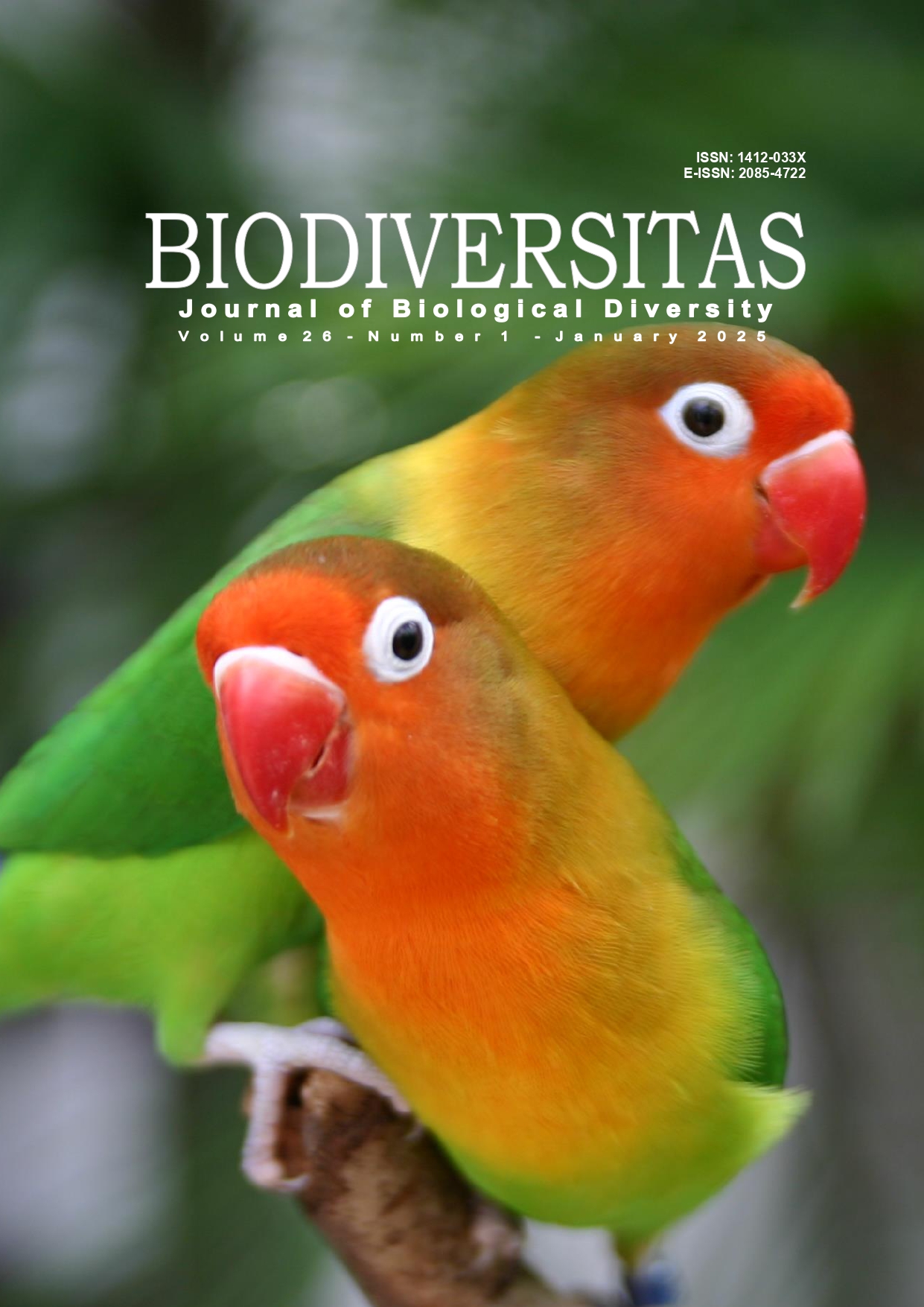Peat-derived Streptomyces spp. isolated from edamame rhizosphere with plant growth-promoting properties
##plugins.themes.bootstrap3.article.main##
Abstract
Abstract. Erdiandini I, Tjahjoleksono A, Astuti RI, Husen E, Wahyudi AT. 2025. Peat-derived Streptomyces spp. isolated from edamame rhizosphere with plant growth-promoting properties. Biodiversitas 26: 326-334. Peatlands, which are known for their high organic matter content, are common habitats for actinomycetes. These microorganisms have been recognized for their potential as plant growth promoters. However, there have been limited reports on peat-derived actinomycetes with plant growth-promoting properties, especially in edamame-cultivated peatlands. This study aimed to isolate and investigate plant growth-promoting actinomycetes in the rhizosphere of edamame-cultivated peatlands. The results showed that a total of 46 strains were isolated from the edamame rhizosphere during the anthesis and reproductive phase. Importantly, 36 of these strains were found to be biologically safe, as showed by the negative hemolysis and hypersensitivity test. All 36 strains produced indole-3-acetic acid in the range of 2.42 to 50.07 µg/mL. Based on the in vivo plant growth-promoting activity assay, strains RT34, AR26, AR39, and BT59 promoted the highest primary root growth of edamame sprouts. Interestingly, the acetylene reduction assay revealed that only RT34 and AR39 strains exhibited nitrogenase activity as high as that of Azotobacter sp. as a positive control. The nitrogenase activity of these strains was up to 27.42 nmol C2H4 h-1tube-1 and 28.10 nmol C2H4 h-1tube-1. Furthermore, quantitative phosphate solubilization assay showed phosphate solubilization up to 527.76 µg/mL in the range of 258.31 to 527.76 µg/mL. Based on 16S rRNA sequencing, these strains were closely related to the genus Streptomyces. The finding of present results strongly indicates that these Streptomyces strains have plant growth-promoting properties and can be proposed as biostimulants to enhance edamame growth in peatlands.
##plugins.themes.bootstrap3.article.details##
Most read articles by the same author(s)
- HERMAWATY ABUBAKAR, RIKA INDRI ASTUTI, SRI LISTYOWATI, IRMANIDA BATUBARA, ARIS TRI WAHYUDI, An orange pigment from the marine bacterium Paracoccus haeundaensis SAB E11 as a prospective source of natural antioxidants , Biodiversitas Journal of Biological Diversity: Vol. 23 No. 9 (2022)
- RAHAYU WULAN, RIKA INDRI ASTUTI, YAYA RUKAYADI, SRI ESTUNINGSIH, ANJA MERYANDINI, Effect of probiotic yeast Pichia kudriavzevii 2P10 and mannan-oligosaccharide on the intestine health of rat infected with Salmonella Typhimurium , Biodiversitas Journal of Biological Diversity: Vol. 26 No. 1 (2025)
- CHEPPY WATI, ABDJAD ASIH NAWANGSIH, ARIS TRI WAHYUDI, SURYO WIYONO, ABDUL MUNIF, Diversity of phyllospheric Actinomycetes in Liliaceae plants and their potential as growth inhibitors of Alternaria porri , Biodiversitas Journal of Biological Diversity: Vol. 24 No. 10 (2023)
- IDA AYU PUTU SURYANTI, MARIA INDAH PURNAMASARI, CAHYA PRIHATNA, IMAN RUSMANA, ARIS TRI WAHYUDI, ANTONIUS SUWANTO, Characterization of endophytic bacterial isolates from oil palm (Elaeis guineensis) seedlings and ramets for their plant growth promoting potential , Biodiversitas Journal of Biological Diversity: Vol. 25 No. 10 (2024)
- DELFIANI ANGGIAS PUTRI, RIKA INDRI ASTUTI, ARIS TRI WAHYUDI, The potency of yellow pigment extract from the marine bacterium Pseudomonas oryzihabitans SAB E-3 as an antioxidant agent , Biodiversitas Journal of Biological Diversity: Vol. 25 No. 6 (2024)
- DOVA KELVIN MESRIAN, RIKA INDRI ASTUTI, MUHAMMAD EKA PRASTYA, ARIS TRI WAHYUDI, Pyocyanin derived from the marine sponge-associated bacterium, Pseudomonas aeruginosa P1.S9, has the potential as antibacterial , Biodiversitas Journal of Biological Diversity: Vol. 25 No. 11 (2024)
- AFINA PUTRI SHABIRA, ARIS TJAHJOLEKSONO, YULIN LESTARI , Endophytic actinobacteria of Eleutherine palmifolia as antioxidant producer , Biodiversitas Journal of Biological Diversity: Vol. 23 No. 8 (2022)

